Cyril Colnik
Cyril Colnik (20 September 1871 – 25 October 1958) was a master metalsmith from Austria. He emigrated to the United States to attend the 1893 World's Columbian Exposition in Chicago where he won the gold medal for his entry to the exposition. He was a pacifist and instead of making armaments for World War I, he closed his business.
Cyril Colnik | |
|---|---|
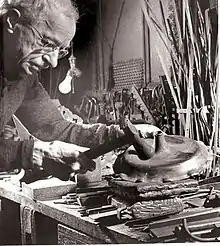 Cyril Colnik at work in his studio | |
| Born | 20 September 1871 Styria, Austria |
| Died | 25 October 1958 (aged 87) Milwaukee, Wisconsin, U.S. |
| Resting place | Wisconsin Memorial Park |
| Alma mater | Munich Industrial Art School |
| Known for | Metal and iron work |
| Partner(s) | Marie C. (nee Merz) Colnik |
| Children | 1 |
| Awards | Gold Medal 1893 Vulcan – Iron |
| Patron(s) | Frederick Pabst |
Early life
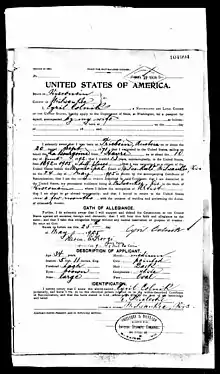
Colnik was born in 1871, in the Austrian village of Trieben, Styria.[1][2] He served an apprenticeship in Graz[3] following which he also studied in France and other countries in Europe before eventually settling in Munich, Germany[2] where he completed his studies at the Munich Industrial Art School.[4] Reinhold Kirsch recognized him as an exceptional student and sent him to America as part of the German ironworking team at the Chicago Exposition.[4]
Career
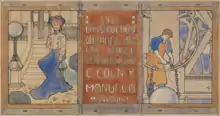
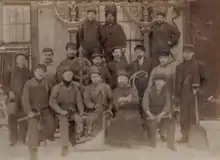
When he came to Chicago in 1893, he was 22 years old.[5] He worked on the hands of a donated clock which was to be displayed at the Chicago World Columbian Exposition.[5] While at the exposition, Colnik entered an example of his work. His entry was a depiction of the mascot of blacksmiths: Vulcan, the God of Fire.[5] He received a gold medal for his grille depicting Vulcan. He also won a prize for his escutcheon entry.[6] The country entered in a depression after the exposition, and so he never received a physical copy of the medal.[5] He decided to stay in Chicago after the end of the exposition.[5]
The brewer Frederick Pabst was showcasing a beer garden at the event.[5] It is thought that Frederick Pabst convinced Colnik to move to Southeastern Wisconsin.[7][8] Colnik created many metal items for the wealthy German brewer including an intricate wrought-iron and antler chandelier which ended up in a Milwaukee tavern called "Von Trier".[9] After moving to Milwaukee, Wisconsin, Colnik operated a wrought iron factory. His work was primarily for the wealthy homeowners in the area.[5] He was a pacifist and knowing that his shop would be called upon to make armaments for the war effort during World War I, he closed his workshop.[5]
He was also commissioned to do work for John Ringling, creating the iron work for the John and Mable Ringling Museum of Art.[3] He retired in 1955[3] and today several of his ironwork sketches and photographs are exhibited at the Villa Terrace Decorative Arts Museum in Milwaukee.[2]
Personal life
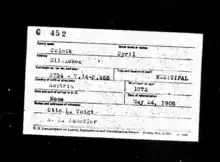
In 1905, Colnik married Marie C. (née Merz) Colnik, and had one daughter.[3][4] He became a U.S. citizen on 24 May 1905.[N 1] His wife Marie died 23 January 1941.[10] On 25 October 1958, he died in Milwaukee, Wisconsin. He was survived by his daughter, Gretchen.[3][11]
See also
References
- Kitchell Whyte, Bertha (1971). Craftsmen of Wisconsin. Racine, Wisconsin: Western Publishing Company. p. 139.
- "Cyril Colnik". Kohler Foundation. Kohler Foundation, Inc. Archived from the original on 5 February 2022. Retrieved 18 December 2021.
- "Cyril Colnik Dies: Museum Iron Craftsman". Tampa Bay Times. 14 November 1958. Archived from the original on 18 December 2021. Retrieved 18 December 2021.
- "Blacksmith Traditions: Cyril Colnik" (PDF). Blacksmiths of Arkansas. Voice May 2015. Archived (PDF) from the original on 29 April 2016. Retrieved 18 December 2021.
- Peterson, Gary (6 August 1981). "The Art that Cyril Colnik Wrought Included Peace". The Capital Times. Archived from the original on 18 December 2021. Retrieved 18 December 2021.
- The Anvil's Ring – Volumes 9–10. Johnstown, Pennsylvania: Artist-Blacksmiths' Association of North America. 1981. p. 3.
- Strekow, Alan J. (2011). Cyril Colnik : man of iron (First ed.). Milwaukee, WI: Friends of Villa Terrace Decorative Arts Museum. ISBN 9780615481418.
- Buchanan, Mel (29 June 2012). "From the Collection–Cyril Colnik Iron Basket". Milwaukee Art Museum. Retrieved 7 March 2022.
- Deptolla, Carol (17 March 2018). "Von Trier bar auctioning off Colnik chandelier, other items". Milwaukee Journal Sentinel. Archived from the original on 18 December 2021. Retrieved 18 December 2021.
- "Death". Wauwatosa Library. Wauwatosa Public Library. Archived from the original on 18 December 2021. Retrieved 18 December 2021.
- "Miss Colnik to Speak May 19". Carbondale Free Press. 9 May 1949. Archived from the original on 18 December 2021. Retrieved 18 December 2021.
Notes
- See Cyril Colnik naturalization card